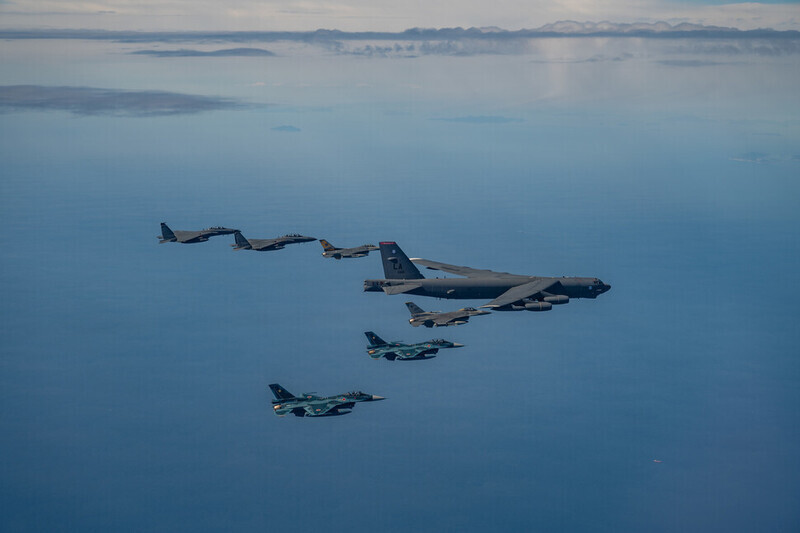hankyoreh
Links to other country sites 다른 나라 사이트 링크
[Column] How long can America maintain a war economy?


The US economy is in reasonably good shape, according to conventional measurements. The official unemployment rate is below 4 percent, and the productivity of US workers is surging. In the last quarter, economic growth was nearly 5 percent, and inflation has been leveling off. Americans are buying things, throwing parties, and going on vacations.
Last year, economists were predicting a recession. It hasn’t happened, not yet at least. In part, that’s because the United States, like many other countries, is still enjoying a rebound from the worst of the COVID pandemic. Led by India, China and Indonesia, the global economy is on pace to grow about 3 percent this year.
The major challenge for the United States is the perennial trade-off between guns and butter, that is, choosing between spending on the domestic economy and on the military. Right now, the Biden administration has turned this dilemma of “either-or” into “both and.” So, now the question is: How long can this increase in spending on both military and non-military sectors of the economy continue?
Since the withdrawal of troops from Afghanistan in 2021, the United States is currently not involved directly in any major wars. It still conducts air strikes in Syria and maintains a contingent of a couple thousand troops in Iraq. About 170,000 US soldiers are active on hundreds of overseas bases, with the largest concentrations in Germany, Japan and South Korea. But the era of significant “boots on the ground” in active conflicts is, at least temporarily, over.
Yet, paradoxically, US military spending is at an all-time high. From 2017 to 2023, the Pentagon’s base budget increased by over 50 percent. For 2024, overall US military spending — which includes the allotment for the Pentagon, the budget for nuclear weapons at the Department of Energy, and a few other items—will be US$886 billion. With supplemental requests, like the current one for Ukraine and Israel, the total will approach US$1 trillion, the highest military spending since World War II.
Only 15 governments in the world have larger overall budgets than what is currently allocated to the US military.
At the same time, the Biden administration has been pushing through very large expenditures on the domestic economy. In 2021, in its first major win, the administration won passage of a US$1.9 trillion stimulus package to respond to the COVID pandemic. It followed up the same year with a US$1 trillion infrastructure bill. The next year, the Inflation Reduction Act provided several hundred billion dollars in climate-related funding. The administration also set aside over US$50 billion for investments in the semiconductor industry.
That’s a lot of government spending on the “butter” side. Of course, some of that spending is offset by revenue generation through additional taxes and other measures. But it still has contributed to the US budget deficit effectively doubling from 2022 to 2023. The overall debt, which is the accumulated total of deficits over the years, now stands at around US$33 trillion. That’s the value of the economies of China, Japan, Germany, India and the UK combined.
The percentage of debt to GDP for the United States is around 121 percent. Other countries, especially Japan, are in worse situations. Governments in the Global South that face that kind of ratio are usually considered in a debt crisis. The United States gets a pass because the dollar is the global currency. The federal government can either raise taxes, issue more bonds, or print more money or to cover the gap between revenues and expenditures.
Still, at a certain point, the United States will have to choose between its addiction to military spending and the economic demands of its population.
Although the United States is not directly engaged in an active conflict, it is sending a lot of support to Ukraine in its battle against Russian occupation forces. Total military assistance is close to US$50 billion. The Pentagon has sent over so much military hardware that it has depleted its own stocks. That’s one reason the United States has persuaded South Korea to send over military assistance on top of the nonlethal support that Seoul is providing.
It’s also why the Biden administration has proposed a US$105 billion supplemental bill, of which US$61 billion is slotted for Ukraine. A huge portion of that US$61 billion — US$44 billion — would actually go to the Pentagon to replenish its stocks for the eventual resupply of the Ukrainian army.
The supplemental also includes money for Israel, for Taiwan, and for further militarizing the border between Mexico and the United States.
Although the military assistance for Ukraine dominates the headlines as well as the battles in Congress, the bulk of US spending actually goes to big-ticket items—ships, planes, space weapons—that have little to do with the war between Moscow and Kyiv.
Indeed, the United States has engaged in a multi-year reorientation of military policy toward Asia. Some part of that reorientation has been to counter North Korea. But aside from its nuclear weapons, which are very difficult to defend against, the Pentagon isn’t really worried about Pyongyang. Although North Korea has a large army, it is largely ineffectual, which explains why Pyongyang has invested so heavily in acquiring a nuclear deterrent.
The Pentagon’s real concern is China, particularly its interest in absorbing Taiwan and extending its control over the South China Sea. China has the only military in the world that comes close to matching the Pentagon’s might. Increasing its military spending by about 7 percent annually over the last few years, China has been incrementally closing the gap.
The United States and China face a challenge. Will they continue to spend heavily on their militaries and risk not only war but bankruptcy, political instability, and economic stagnation at home?
This is no small issue. To deal effectively with the threat of climate change, China and the United States must not only cooperate but also free up funds to help the rest of the world make an equitable transition away from fossil fuels. So, yes, it is theoretically possible for the United States and China to continue to invest heavily into both guns and butter even while avoiding war and economic collapse.
But the planet can’t afford that strategy.
Please direct questions or comments to [english@hani.co.kr]

Editorial・opinion
![[Column] Is Korean democracy really regressing? [Column] Is Korean democracy really regressing?](https://flexible.img.hani.co.kr/flexible/normal/500/300/imgdb/original/2024/0705/2917201664129137.jpg) [Column] Is Korean democracy really regressing?
[Column] Is Korean democracy really regressing?![[Column] How tragedy pervades weak links in Korean labor [Column] How tragedy pervades weak links in Korean labor](https://flexible.img.hani.co.kr/flexible/normal/500/300/imgdb/original/2024/0703/8717199957128458.jpg) [Column] How tragedy pervades weak links in Korean labor
[Column] How tragedy pervades weak links in Korean labor- [Column] How opposing war became a far-right policy
- [Editorial] Korea needs to adjust diplomatic course in preparation for a Trump comeback
- [Editorial] Silence won’t save Yoon
- [Column] The miscalculations that started the Korean War mustn’t be repeated
- [Correspondent’s column] China-Europe relations tested once more by EV war
- [Correspondent’s column] Who really created the new ‘axis of evil’?
- [Editorial] Exploiting foreign domestic workers won’t solve Korea’s birth rate problem
- [Column] Kim and Putin’s new world order
Most viewed articles
- 110 days of torture: Korean mental patient’s restraints only removed after death
- 2What will a super-weak yen mean for the Korean economy?
- 3Real-life heroes of “A Taxi Driver” pass away without having reunited
- 4Koreans are getting taller, but half of Korean men are now considered obese
- 5Ahead of 2018 Olympics, hanok village opens in Gangneung
- 6Members of North Korea’s cheerleading squad reflect on their Olympic experience
- 7Former bodyguard’s dark tale of marriage to Samsung royalty
- 8[Column] Is Korean democracy really regressing?
- 9Democrats ride wave of 1M signature petition for Yoon to be impeached
- 10Japan’s lack of transparency on Fukushima water is sparking fear in neighbors, says Japanese expert